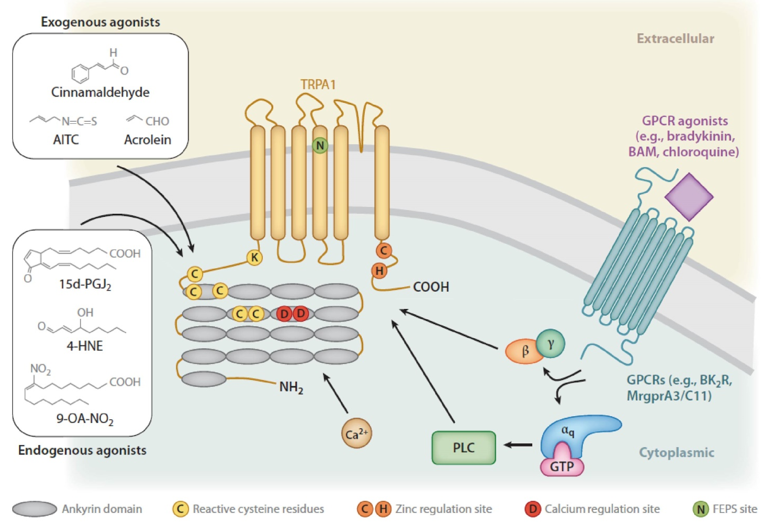
Our promise to you:
Guaranteed product quality, expert customer support.
 24x7 CUSTOMER SERVICE
24x7 CUSTOMER SERVICE
 CONTACT US TO ORDER
CONTACT US TO ORDER
TRPA1 Gene Editing 
TRP ion channels have important roles in somatosensation by serving as sensors for thermal and chemical stimuli. In mammals, the TRPA1 subtype is expressed by primary afferent nociceptors, where it detects structurally diverse noxious compounds that elicit pain and neurogenic inflammation. Such activators include pungent irritants from onion, mustard and garlic, as well as endogenous pro-algesic agents and volatile environmental toxins. TRPA1 is also activated by endogenous inflammatory mediators and plays a crucial role in transducing nociceptive signals associated with tissue damage and inflammation. Indeed, TRPA1 is expressed specifically in peptidergic C-fibers, which release an endogenous neurogenic inflammatory cocktail, containing Calcitonin gene-related peptide (CGRP), substance P, and neurokinins, leading to the initiation of cellular responses and tissue inflammation.
 Figure 1. Diverse mechanisms of TRPA1 activation. (Bautista D M, et al. 2013)
Figure 1. Diverse mechanisms of TRPA1 activation. (Bautista D M, et al. 2013)
TRPA1 as a promising therapeutic target
The well-established role of TRPA1 in chemical nociception, combined with the phenotype of the knockout animals and the contribution of a gain-of-function TRPA1 mutation to a human pain syndrome, make TRPA1 an attractive target for analgesic intervention. In fact, several pharmaceutical companies have launched drug discovery programs that are aimed at the design and synthesis of potent and selective small molecule TRPA1 inhibitors as potential analgesic and anti-inflammatory agents. In preclinical models, TRPA1 antagonists showed promise in dental pain, diabetic neuropathy, chemotherapy-mediated neuropathic pain and colicky pain.
TRPA1 is also emerging as a promising therapeutic target for the treatment of respiratory disorders, including asthma, chronic cough and chronic obstructive pulmonary disease (COPD). Both in animal models and human volunteers, exogenous and endogenous irritants that are capable of activating the TRPA1 channel produce typical symptoms related to respiratory dysfunctions such as chest tightness, cough, wheezing, dyspnea and heightened sensitivity. Besides, TRPA1 plays a key role in sensing pulmonary oxidative stress. Therefore, selective TRPA1 inhibitors have attracted an increasing interest as possible agents for the management of inflammatory-related respiratory diseases. For example, it has been suggested that genetic inactivation and/or pharmacological blockade of TRPA1 is beneficial in a murine ovalbumin model of asthma.
TRPA1 antagonists
TRPA1 antagonists contain a wide range of organic and inorganic chemicals characterized by heterogeneous chemotypes. Ruthenium red, amiloride, gentamicin and gadolinium were recognized among the first blockers of the TRPA1 channel, even though nonspecific over other ion channels. HC-030031 and A-967079 represent the two main classes of TRPA1 antagonists. HC-030031 showed high selectivity for TRPA1 over almost 50 different targets (including receptors, enzymes and transporters) involved in pain transmission. Apart from selective antagonists of TRPA1, endogenous inhibitory pathways may offer a fruitful approach to selectively targeting TRPA1. The ω-3 polyunsaturated fatty acid-derived resolvins are effective anti-inflammatory agents found at sites of inflammation. Resolvin D1 selectively inhibits TRPA1 activity, whereas resolvin E1 selectively inhibits TRPV1 activity. Resolvins attenuate inflammatory hypersensitivity to mechanical and thermal stimuli without affecting basal pain processing. Although Gi-coupled GPCRs are implicated in resolvin signaling, the molecular mechanisms underlying TRP channel specificity remain to be determined. However, molecules that target specific resolvin-mediated GPCR signaling pathways may allow selective treatment of TRPA1-mediated inflammation and pain.
TRPA1 Gene Editing Service
CRISPR/Cas9 PlatformCB at Creative Biogene is dedicated to offering comprehensive CRISPR/Cas9 gene editing services and products for academic research, biotech research and pharmaceutical drug discovery. With deep gene editing knowledge and extensive experience in experimental operation and data processing, we help you effectively control TRPA1 gene knockout/knockin/point mutation in cells or animals via CRISPR/Cas9 technology.
| Service | Details | Alternative cell lines or animal species |
| TRPA1 Gene Editing Cell Line Generation |
| HEK239T, Hela, HepG2, U87, Ba/F3, CHO, MDA-MB-453, MDA-MB-231NIH3T3, T47D, Neuro2a, MCF7, RKO, K562, RAW264.7, etc. |
| TRPA1 Gene Editing Animal Model Generation |
| Mouse, rat, rabbit, zebrafish, C. elegans, etc. |
Related Products at CRISPR/Cas9 PlatformCB
References
- Paulsen C E, et al. Structure of the TRPA1 ion channel suggests regulatory mechanisms. Nature, 2015, 520(7548): 511.
- Laursen W J, et al. TRPA1 channels: chemical and temperature sensitivity. Current topics in membranes. Academic Press, 2014, 74: 89-112.
- Preti D, et al. Transient receptor potential ankyrin 1 (TRPA1) antagonists. Pharmaceutical patent analyst, 2015, 4(2): 75-94.
- Bautista D M, et al. TRPA1: A gatekeeper for inflammation. Annual review of physiology, 2013, 75: 181-200.
- Chen J, Hackos D H. TRPA1 as a drug target—promise and challenges. Naunyn-Schmiedeberg's archives of pharmacology, 2015, 388(4): 451-463.